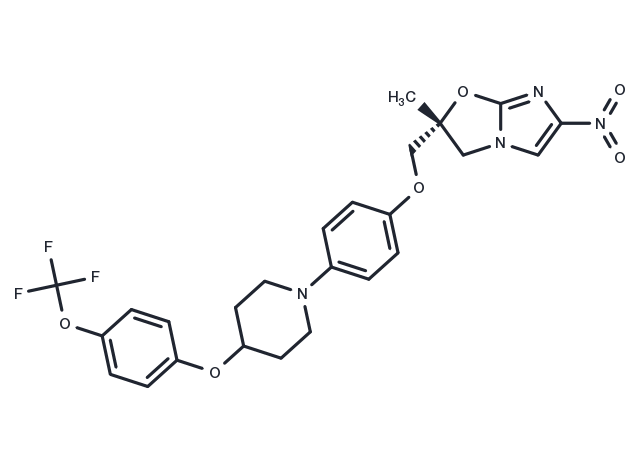Powder: -20°C for 3 years | In solvent: -80°C for 1 year


Delamanid (OPC-67683) is an anti-tuberculosis agent derived from the nitro-dihydro-imidazooxazole class of compounds that inhibits mycolic acid synthesis of bacterial cell wall.

| Pack Size | Availability | Price/USD | Quantity |
|---|---|---|---|
| 5 mg | In stock | $ 39.00 | |
| 10 mg | In stock | $ 64.00 | |
| 25 mg | In stock | $ 126.00 | |
| 50 mg | In stock | $ 225.00 | |
| 100 mg | In stock | $ 365.00 | |
| 500 mg | In stock | $ 855.00 | |
| 1 mL * 10 mM (in DMSO) | In stock | $ 46.00 |




| Description | Delamanid (OPC-67683) is an anti-tuberculosis agent derived from the nitro-dihydro-imidazooxazole class of compounds that inhibits mycolic acid synthesis of bacterial cell wall. |
| In vitro | In vitro: inhibits the synthesisi of mucolic acids, cruciala component of the cell wall of the Mycobacterium tuberculosis complex.[1] In in-vitro studies, delamanid shows more potent antibacterial activity against drug-susceptible and drug-resistant strains of M. tuberculosis.[2] Delamanid do not affect rifampin, pyrazinamide, and isoniazid exposure; the ethambutol AUCτ and Cmax values are about 25% higher with delamanid coadministration. |
| In vivo | In vivo: Twice-daily oral dosing of delamanid at 30 mg kg-1 for 5 days resulted in sterile cures in a mouse model of VL. [4] |
| Kinase Assay | In a 200 μL reaction volume, 1 μM TEM-1 is incubated with and without 5 μM Avibactam for 5 min at 37°C and subjected to two ultrafiltration cartridge (UFC) steps to remove excess inhibitor (Ultrafree-0.5 with Biomax membrane, 5-kDa cutoff). Centrifugation at 10,600× g for 8 min is performed at 4°C. After each ultrafiltration step, 20 μL retentate is diluted with 180 μL assay buffer to restore the original enzyme concentration. After two UFC treatments, the amount of free Avibactam is quantified by LC/MS/MS and found to be <5% of the original concentration. Loss of protein during UFC is assessed by measuring TEM-1 activity (on 4,000-fold dilution) in the acyl-enzyme sample compare with a non-UFC-treated enzyme, and loss is found to be <5%[1]. |
| Synonyms | OPC-67683 |
| Molecular Weight | 534.48 |
| Formula | C25H25F3N4O6 |
| CAS No. | 681492-22-8 |
Powder: -20°C for 3 years | In solvent: -80°C for 1 year
DMSO: 50 mg/mL (93.55 mM)
You can also refer to dose conversion for different animals. More
bottom
Please see Inhibitor Handling Instructions for more frequently ask questions. Topics include: how to prepare stock solutions, how to store products, and cautions on cell-based assays & animal experiments, etc.
Delamanid 681492-22-8 Microbiology/Virology Anti-infection Antibacterial Antibiotic Bacterial inhibit Inhibitor OPC67683 OPC-67683 OPC 67683 inhibitor
